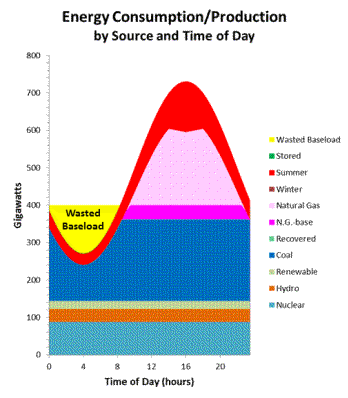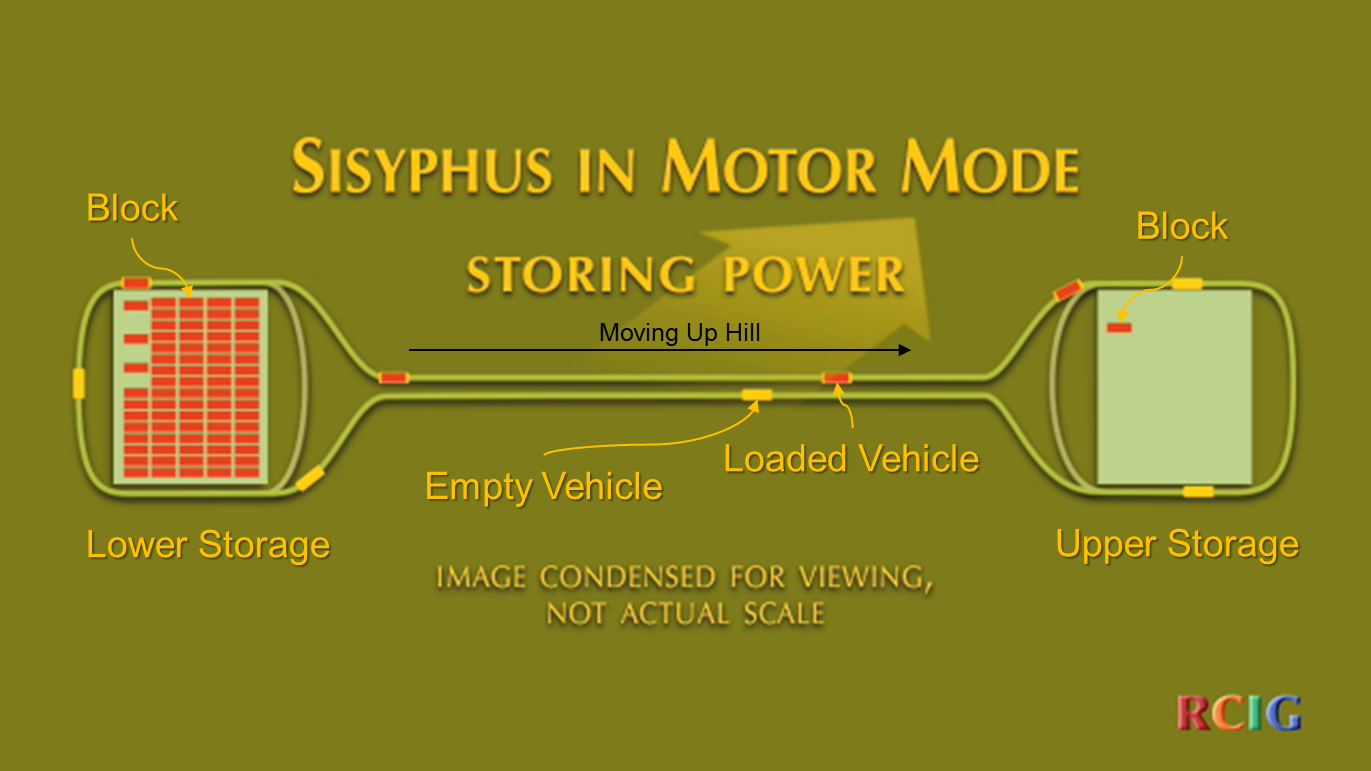Sisyphus Energy, Inc.

We take our name from the myth of Sisyphus, who was forced by the Greek gods to roll a massive boulder up a hill every day, only to have it roll back down during the night. He had to repeat this process forever. The Sisyphus energy storage system stores energy by transporting massive blocks uphill during off-peak hours (night rather than day) and recovers the energy by their return to the bottom during peak hours (day rather than night). This concept is the heart of the solution to the energy problem.
The Energy Storage Problem:
Energy demand is not constant throughout the day; however, energy production is most efficient and least costly when it is constant.
Due to the cost and inevitable inefficiencies of powering down and back up in short intervals, many power plants remain “on” and generate electricity around the clock. Reliable electric power must be available 24/7 for the homes, offices and industries that power plants serve. Generally energy is not stored, but must be provided constantly through the power grid to fulfill all demands. High demand is now being met by expensive natural gas “peaking” generators. On the other hand, when demand is low, continuous off-peak overnight running consumes a huge amount of fuel, even when the electrical demand, and hence required output current, is greatly reduced or absent. This massive fuel consumption is wasted the expense of our natural resources, while also needlessly increasing operating overhead costs. The solution is to make full use of the generators overnight by efficiently drawing off electrical power to energy storage systems. The stored energy can then be fed back into the grid during the day to cope with peaks in demand and, as a result, to avoid the use of expensive peaking generators. Consequently, presently wasted and fiscally very valuable resources can be transformed into highly productive assets.

The figure to the right is developed from data supplied by the U.S. Energy Information Agency (2011) and the International Energy Agency (2010), shows the average U.S. energy consumption/production by source and time of day (both Summer and Winter averages). The baseline is a production level between the low point and the high point of demand. For this data, it is about 400 gigawatts of energy.
As shown in the figure, nuclear power represents a about 20% of baseline use. Hydropower (from dams) and renewable sources (wind, solar, etc.) represent small fractions. Coal represents about 50%. And natural gas supplies a small part of the baseline needs. Nuclear power and coal are relatively inflexible sources. A nuclear reactor needs to run at a constant temperature, producing a constant output. Older coal-fired power plants have the same requirement. They can be shut down; however, this is not something that can be done to adjust for hourly demand changes. Some newer coal-fired power plants can reduce output by changing the physical combustion point in boilers; however, this has only minor impact on power output. Dams can spill water, rather than running it through the generators, and can reduce flow rates; however, they also have constraints on water level behind the dam and flow rates below the dam and depend on rainfall levels. These factors mean that additional changes to meet varying hourly demand levels are not popular with the operators. Renewable power depends on weather and cannot be used for variable demand adjustments. Natural gas turbine plants are capable of adjusting to hourly, daily and seasonal demands and are the main source of such adjustments. However, shutting down any generating capacity represents a waste of the capital used in creating the generating capacity.
The section of the figure labeled "Wasted Baseload" represents generating capacity that is not used because the demand is too low. The cumulative gigawatt hours of power represented by this section comprises the most obvious opportunity for better management of the energy supply. If this available energy is captured and stored, then it can be used during the peak hours, reducing the need for the total capacity during those hours, specifically the capacity generated by natural gas or coal. On the other hand, there is a strong case for additional nuclear power for national energy independence and greenhouse gas reduction; however, the requirement for constant temperature operation would increase the amount of wasted energy during hours of off-peak demand.
The Solution
The very efficient Sisyphus energy storage system completely remedies the energy storage problem.

Sisyphus is a system for storing and recovering electrical energy. Sisyphus stores the energy by moving massive blocks from a low point to a high point, converting the electrical energy into potential energy. It recovers the energy by moving the blocks from the high point to the low point, converting the potential energy back into electrical energy. Because it uses superconducting magnets to move the blocks, it has an efficiency of greater than 90%. Click on the figure to the right for a demonstration and explanation.
To store more energy, Sisyphus only needs to move more blocks, which are inexpensive. This means that it scales well, costing less per megawatt hour (MWH) stored as the system size increases. Sisyphus systems can be built anywhere that has a significant height differential (>600 m), with slopes from 25% grade to vertical (including mine shafts). That means that 1 gigawatt-hour (1000 megawatt-hour) Sisyphus systems can be built almost anywhere in the U.S. and will deliver locally useful amounts of stored energy.
Sisyphus systems can be built at a lower cost than creating new power plants or running existing power plants for peak-demand use. Fossil fuel plants that generate greenhouse gases can be phased out without worrying about the problem of varying electric power demands. Alternative power sources, such as wind and solar that do not supply constant power, will generate power when feasible for use when needed.
Because the Sisyphus system supports variable energy recovery rates, it can surge its energy recovery to support rapid local load balancing. In addition, Sisyphus’ local energy storage will support smaller grid segmentation, which will make the power grid much more secure against failures and hostile attacks.
The Sisyphus concept is a transformative improvement of an earlier generation American magnetic levitation technology that is in commercial development in Japan. The patented improvements have been tested at the component level and will be tested at the system level during the project to build a 200 MWH demonstration system. This system developed by this proposal will then be upgraded to a commercial 1000 MWH system.
SEI's Mission
- Build commercial, grid-level energy storage systems using superconducting magnetic levitation technology.
- Foster industrial growth in Oak Ridge, TN, our home town.
- Pursue other applications of superconducting magnetic levitation technology.
Summary:
Sisyphus is the solution to these acute problems, providing a vital missing element in the national and international quest for higher energy efficiency, greater security and lower greenhouse gas emissions.
|
Sisyphus Energy Storage
|
